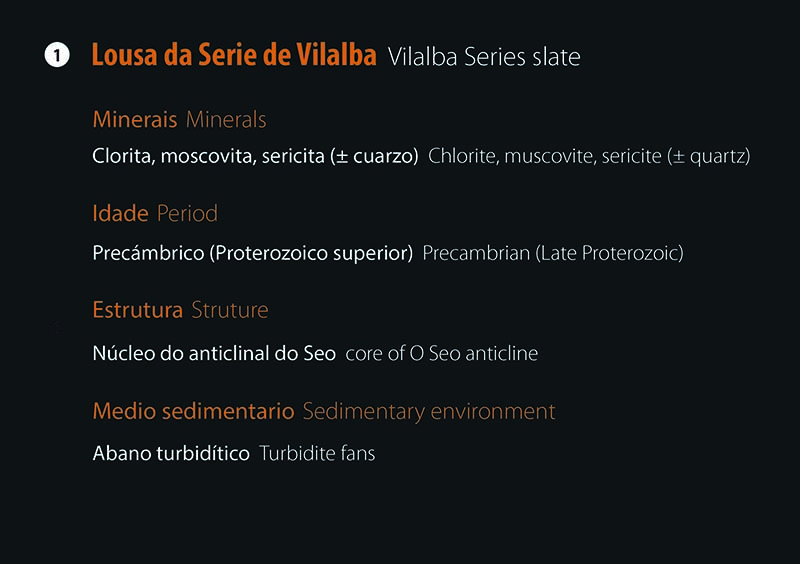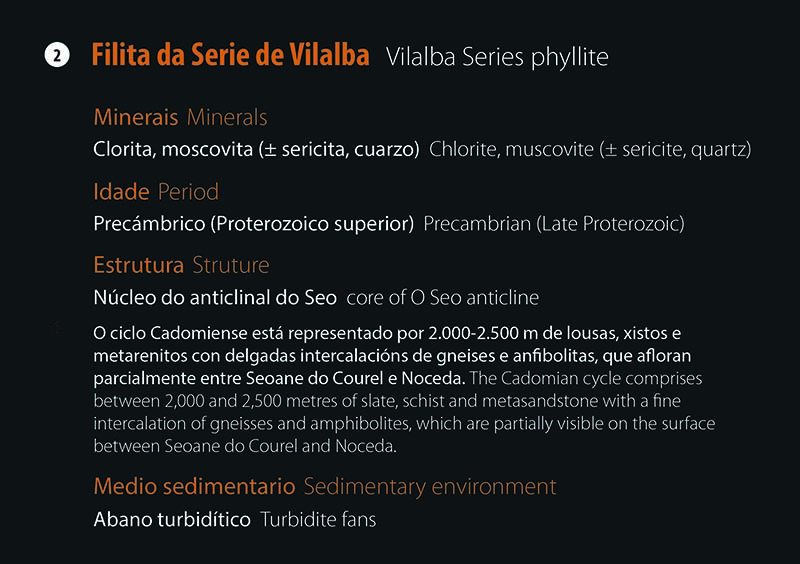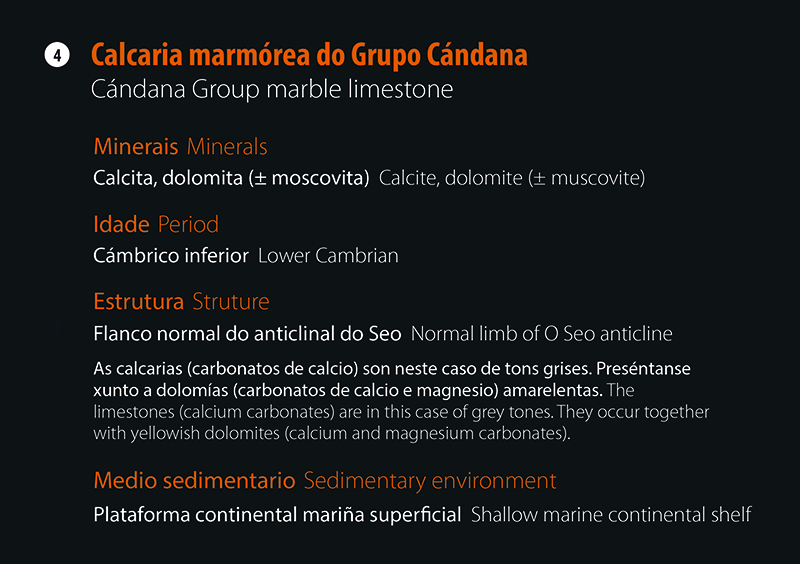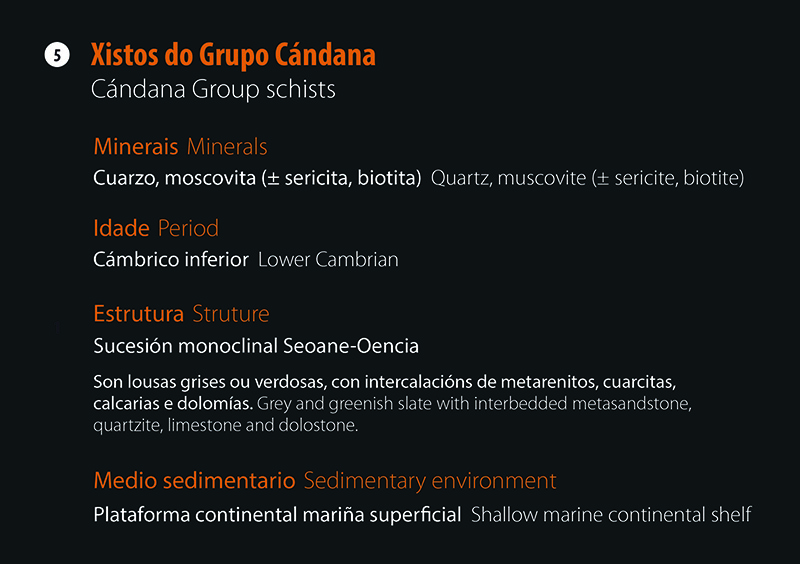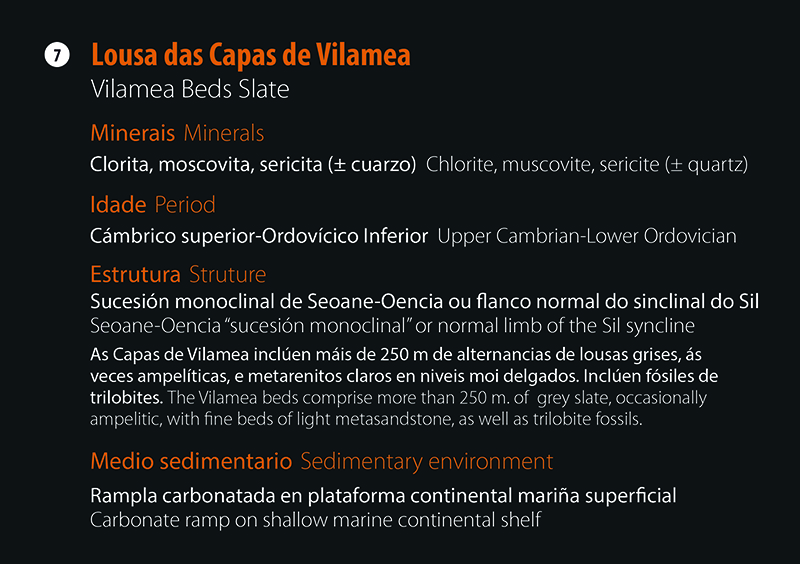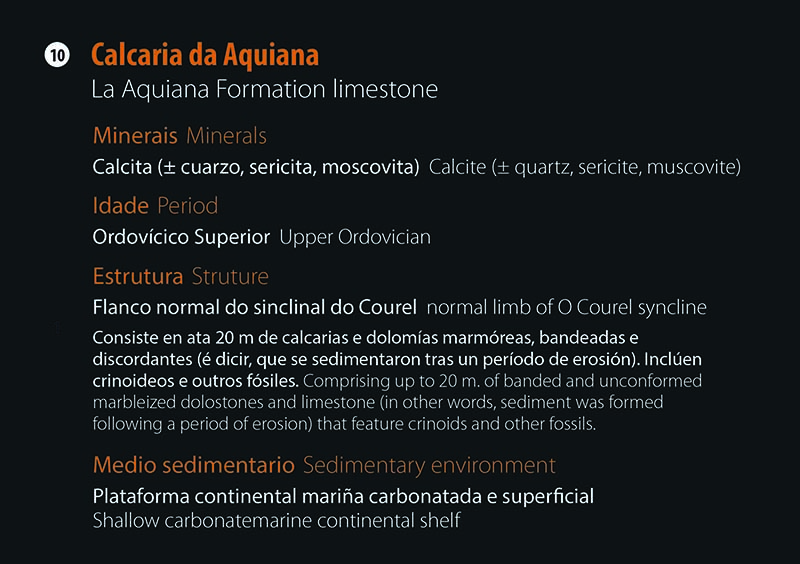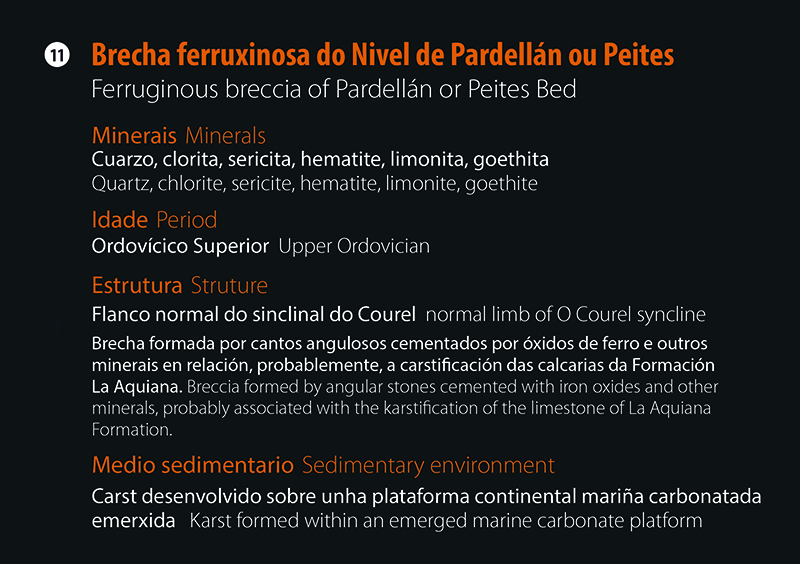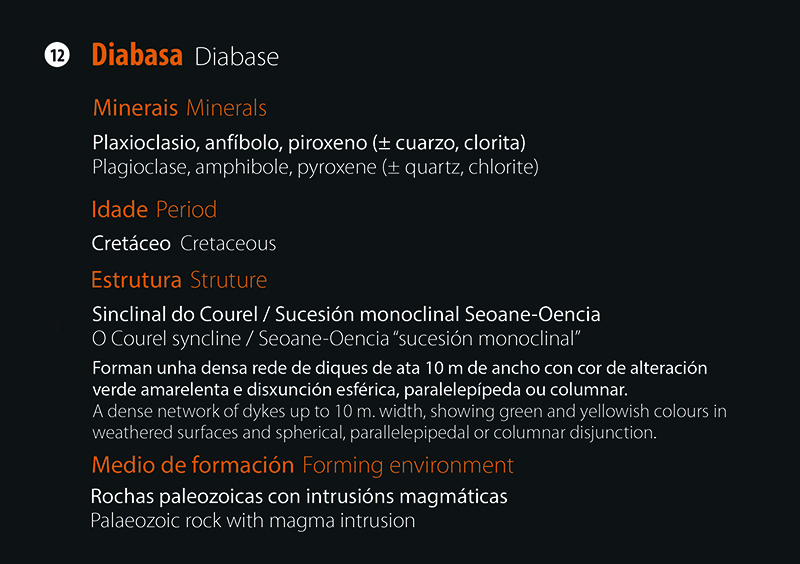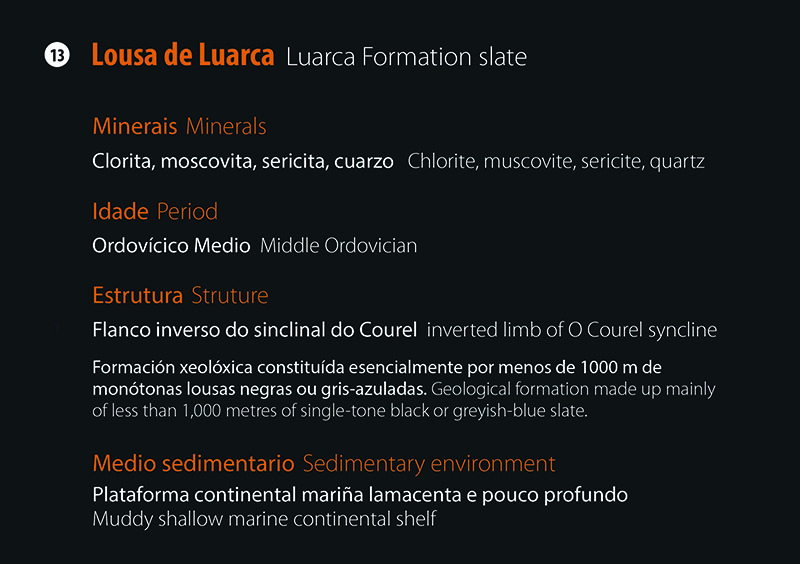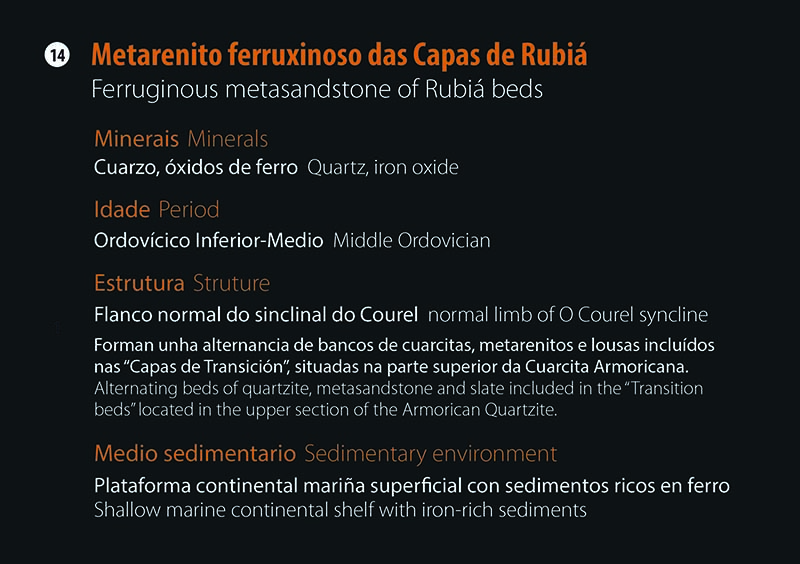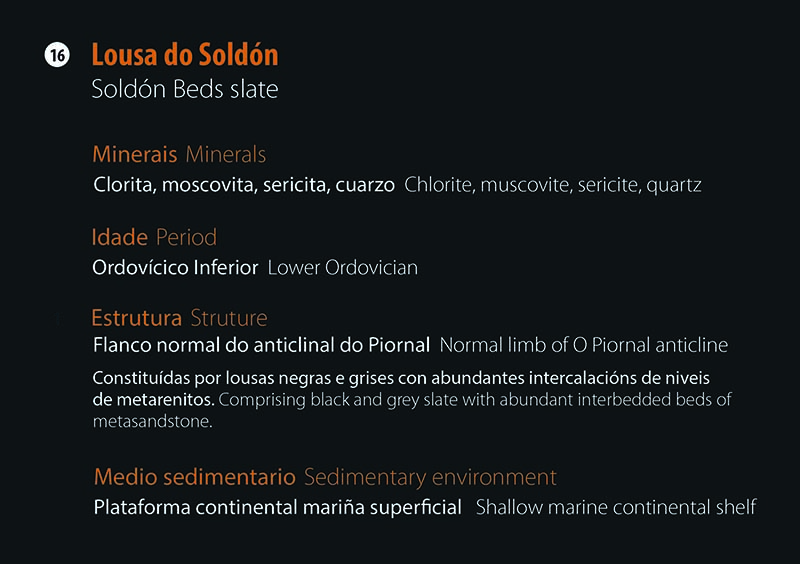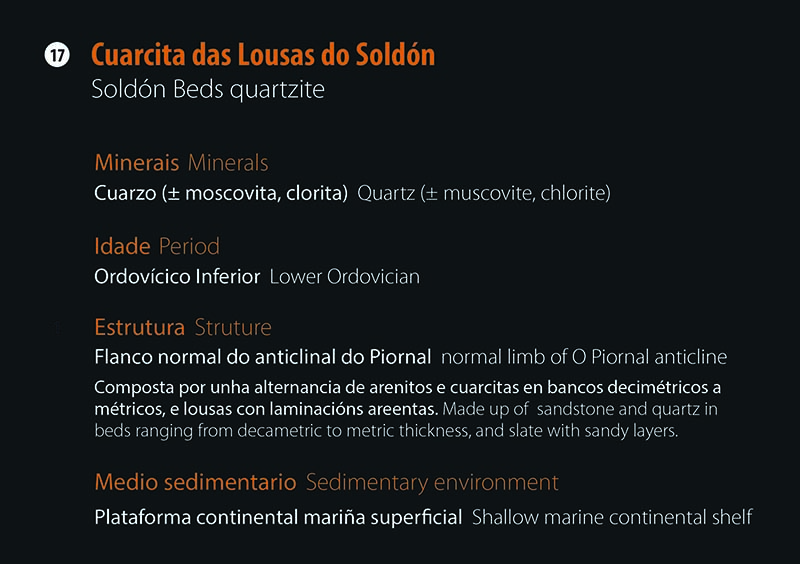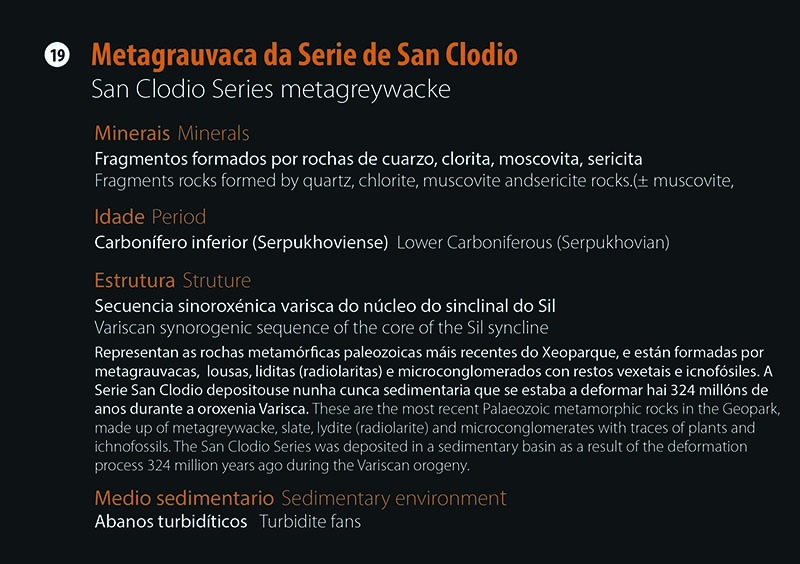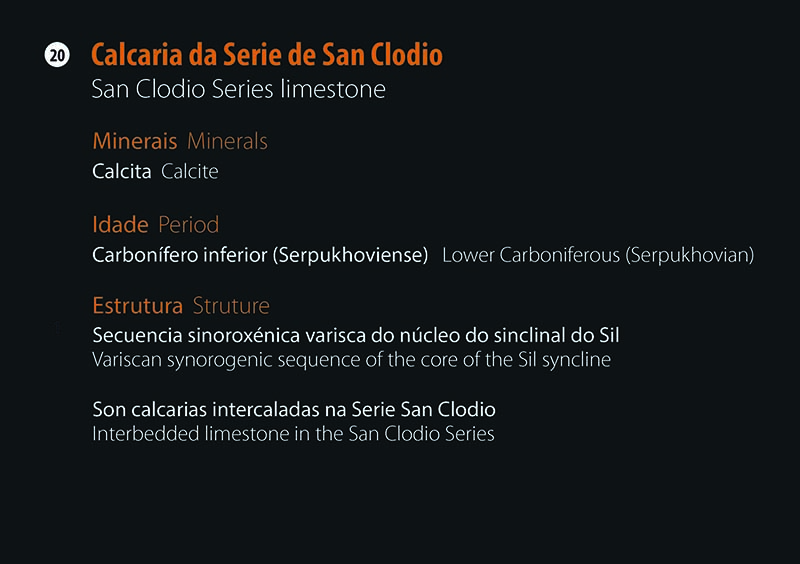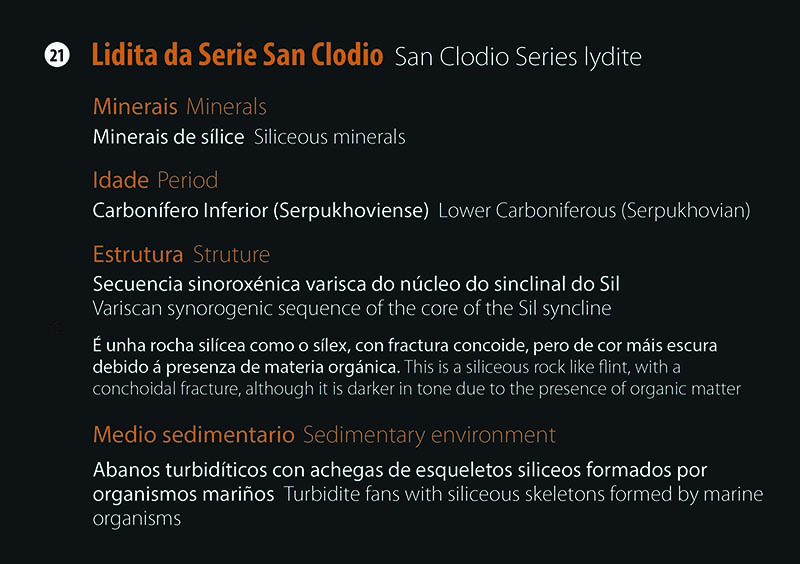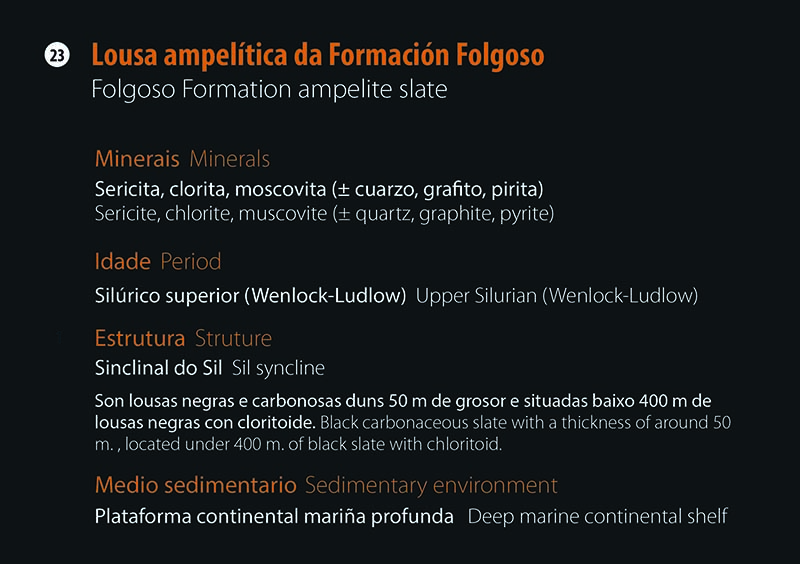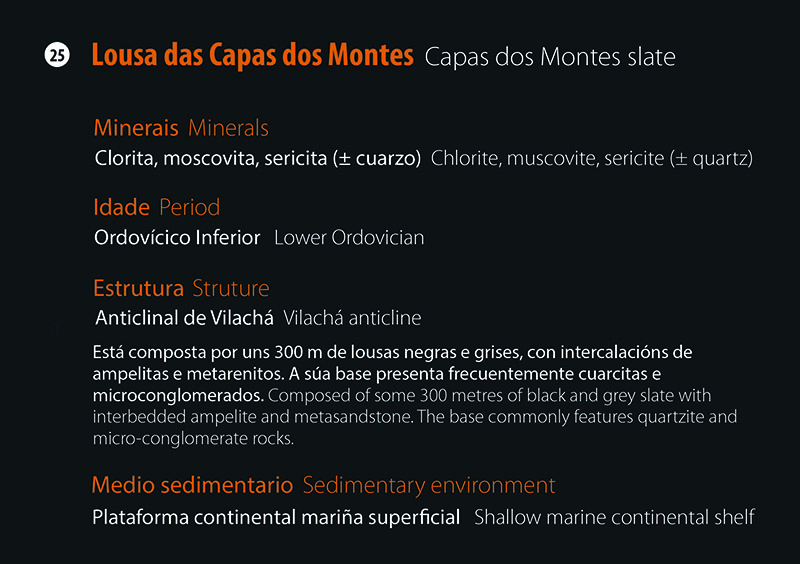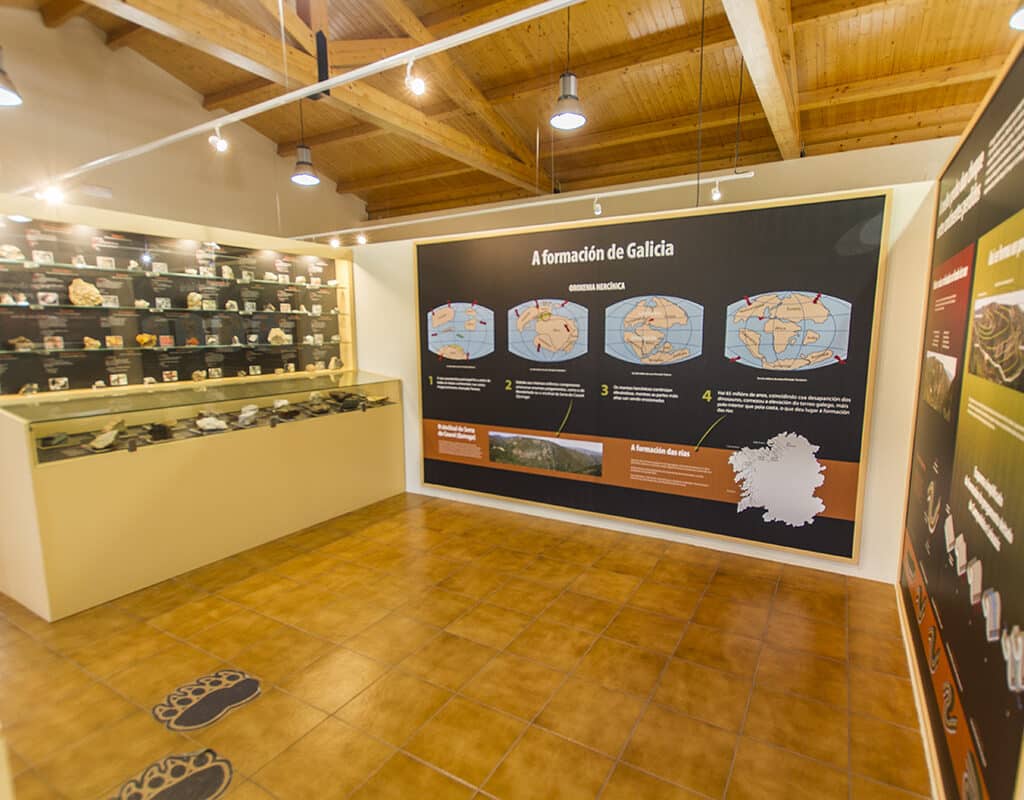
THE GEOLOGICAL FORMATION OF GALICIA
The syncline of the Sierra de O Courel and the roks of the geopark.
In this room we can see the analysis of the Campodola-Leixazós folding (Courel synclinal), one of the main geological events that define the territory of Galicia as we know it today. How and when was it formed? What is a folding? What types of folds are there?

THE BEST TEST OF A COLLISION BETWEEN LOST CONTINENTS.
Some rocks originated at the bottom of the sea.The slates and quartzites that make up the glue were formed from marine sediments deposited during the Lower Paleozoic, between 570 and 410 million years old, on the Laurasia and Gondwana plates.The long history of the majestic folding of Campodola and Leixazós began some 350 million years ago. Galicia, as we know it, did not yet exist. In fact, it was divided into two parts. The western half belonged to the continent of Laurasia and the eastern half to Gondwana. Between the are there was an ocean. Then the underwater plates of both parties began to approach until colliding and emerging. The best and most spectacular proof of that crash is the folding of Campodola and Leixazós.
THIS IS HOW A FOLD IS FORMED.
The folding is born by the effect of the tectonic pressure (from the interior of the #Terra) on the external layers of the earth’s crust, adopting different forms depending on the relative hardness or plasticity of each of the layers and according to the direction of the pressure on them .
TYPES OF FOLDING.
The main types of folding, according to the shape produced by both the direction and intensity of the tectonic forces in the earth’s crust and the consistency and arrangement of layers of different materials (soft and hard rocks, soft sediments, etc.)
Straight or vertical bending, axis or bending line of 90º with the horizontal.
Inclined bending, axis or bending line between vertical and 45º.
Flat bending, axis or bending line with a greater inclination of 45º.
Recumbent fold, axis or horizontal flexion line.

THE FORMATION OF GALICIA – HERCINIC OROGENIA.
450 million years ago (Ordovician period). Its main characteristic was the union of all the continental masses in a single megacontinent called Pangea.350 million years ago (Carboniferous period). Due to the intense compressive efforts, enormous folds are originated, such as that of Mondoñedo or the syncline of the Sierra del Courel (Quiroga).There are 350 million years ago, the great continents of Laurasia and Gondwana, previously separated by an ocean, the Rheic Ocean, were united after a great collision. Galicia arose from this clash, which had previously divided its territory into the two continents. The collision caused the ocean sediments to emerge, which are what formed the folding of the Sierra del Courel (Quiroga), the first emerged land of current Galicia.250 million years ago (Triassic period). The Hercynian mountains continue to rise, while the highest parts are being eroded.65 million years ago (tertiary period). There are 65 million years, coinciding with the disappearance of the dinosaurs, the elevation of the Galician land began, more inland than along the coast, which led to the formation of estuaries.
THE FORMATION OF THE RIAS
During the Tertiary Era, a series of fractures in two directions occurred on the Galician coast: north-south and northwest-southeast. Some of these fractures are the origin of the estuaries. At the end of this era there are movements of elevation of emerged areas, and the rivers embedded, excavating valleys.In the Quaternary, warmer weather causes glaciers to melt. The sea level thus rises, which invades the river valleys, forming the estuaries.

*ANDALUSITE. From Ferreira (Montefurado, Quiroga)
-Class 9.AF.10 (Strunz)
-Chemical formula Al2 O SiO4
-Applications 95% of andalusite is used to produce refractory materials. In addition, it is used in construction and for the manufacture of thermal insulation.
.Physical properties
-Brown, green, pink, purple and red.
-White Stripe
-Hardness 7 – 7.5
*ANTIMONITE OR STIBINE. Extracted from Vilarbacú (Vilarbacú-Quiroga)
-Class 2.DB.05a (Strunz)
-Chemical formula Sb2S3
-Applications It is the main mineral of antimony, a relatively rare and highly toxic metal. It is used to harden metal alloys for supports, battery terminals, and semiconductors.
.Physical properties
-Lead gray color
-Grey stripe
-Hardness 2
*ARAGONITE. Sample from Visuña (Visuña, Folgoso do Courel)
-Class 5.AB.15 (Strunz)
-Chemical formula CaCO3
-Applications As an ornamental or collector’s stone..Physical properties
-Color Generally white. Purplish, brown, black, blue or green.
-White Stripe
-Hardness 3.5 – 4
*ARSENOPYRITE. Sample from Casares (Ribas de Sil)
-Class 2.EB.20 (Strunz)
-FeAsS chemical formula
-Applications It is used for the extraction of arsenic, although it is exploitable due to its gold, silver, cobalt and nickel content. Physical properties
-White and steel gray.
-Grey-black stripe.
-Hardness 5.5 – 6.
*BLEND OR SPHERALITE. Sample from Visuña (Visuña, Folgoso do Courel)
-Class 2.CB.05a (Strunz)
-ZnS chemical formula
-Applications It is the main mineral of zinc, which, allied with the work, gives the brass. In addition, it is used to galvanize iron, the manufacture of paints, the preservation of wood (zinc chloride)…
.Physical properties
-Color Varies between yellowish and black
– Impure white and yellow stripe
-Hardness 2.5 – 3.
*CALCITE. Sample from Visuña (Visuña, Folgoso do Courel)
-Class 5.AB.05 (Strunz)
-Chemical formula CaCO3
-Applications It is estimated that approximately 4% by weight of the earth’s crust is calcite. It is a material widely exploited in quarries and is used for a wide variety of uses: cement and mortar, construction stones, gravel, agricultural fertilizers…
.Physical properties
-Color White, yellow, red, orange, blue, green, brown, grey…
-White Stripe
-Hardness 3
*CYANITA (destination). Sample from Cereixido-Roblido (Quiroga)
-Class 9.AF.15 (Strunz)
-Chemical formula Al2SiO5
-Applications It is mainly used in refractory and ceramic products, including porcelain. Also in the manufacture of electrical tools and as a precious stone.
.Physical properties
-Color blue. Also green, white, gray and black.
-White Stripe
-Hardness 4.5 -5 parallel / 6.5 – 7 perpendicular
*CINNABAR. Sample of Saint Euphemia (Folgoso do Courel)
-Class 2.CD.15a (Strunz)
-Chemical formula HgS
-Applications In ancient times it was used to preserve human bones and to prepare an elixir that was supposed to increase longevity. It is an important source of mercury and is also used in scientific instruments, electrical devices, orthodontics…
.Physical properties
-Red color
-Scarlet Stripe
-Hardness 2 – 2.5
*HYALINE QUARTZ. Sample of Cereixido (Cereixido, Quiroga)
-Class 4.DA.05 (Strunz)
-SiO2 chemical formula
-Applications It is an excellent conductor and channeler of light waves, which is why it is used to control the accuracy of electronic circuits.
.Physical properties
-Transparent color
-White Stripe
-Hardness 7
*MILKY QUARTZ. Vilarbacú mineral sample (Vilarbacú, Quiroga)
-Class 4.DA.05 (Strunz)
-SiO2 chemical formula
-Applications Widely used, both for microelectronics and for manufacturing glass and ceramics or building materials.
.Physical properties
-White, translucent. Depending on the variation, it can also be pink, reddish or black.
-White Stripe
-Hardness 7
*DOLOMITE. Found in Visuña (Visuña, Folgoso do Courel)
-Class 5.AB.10 (Strunz)
-Chemical formula CaMg(CO3)2
-Applications It is used as a source of magnesium, as well as in the manufacture of refractory materials, flux in metallurgy, manufacture of ceramics, paints and white fillers and as a component to manufacture glass.
.Physical properties
-Sen color, pink
-White Stripe
-Hardness 3.5 – 4
*STIBICONITE. Sample of Vilarbacú (Vilarbacú, Quiroga)
-Class Hydroxides (Strunz)
-Chemical formula Sb3+Sb5+2O6 (OH)
-Applications It is used as antimony ore.
.Physical properties
-Color Dirty white to pale yellow
-White Stripe
-Hardness 4 – 5.5
*FUCHSITA OR CHROME-MOSCOVITE. Sample of Vilarbacú (Vilarbacú, Quiroga)
-Class 9.EC.15
-Chemical formula K(Al,Cr)2AlSi3O10(OH,F)2
It is a variety of green muscovite due to its chromium content.
-Applications It is used as an ornamental stone. It is an excellent conductor and channeler of light waves, which is why it is used to control the accuracy of electronic circuits.
.Physical properties
-Colorless, although with light yellow, brown, green or red tones.
-White or colorless stripe
-Hardness 2 – 2.5
*GALENA. Sample of Visuña (Visuña, Folgoso do Courel)
-Class 2.CD.10 (Strunz)
-Chemical formula PbS
-Applications It is one of the lead minerals. In ancient Egypt it was used as a base for kohl, a cosmetic powder used to protect the eyes. It was also used in the preparation of glazes for ceramics. In the primitive radios it was used as a signal capture element.
.Physical properties
-Lead gray color, slightly lighter if it contains silver
-Polomo gray stripe
-Hardness 2.5 – 3
*GROSSULARY. Sample of Montefurado (Montefurado, Quiroga)
-Class 9.AD.25 (Strunz)
-Chemical formula Ca3Al(SiO4)3
-Applications It is marketed as a gem, cutting pure crystals, with a beautiful color. The best specimens are highly sought after by museums and collectors. Physical properties
-Color Brown to colorless, gray, green, yellow.
-White to brownish stripe
-Hardness 6.5 – 7
*KERMESITA. Sample of Vilarbacú (Vilarbacú, Quiroga)
-Class 02.FD.05 (Strunz)
-Chemical formula Sb2S2O
-Applications His interest is scientific and collecting.
.Physical properties
-Cherry red or brownish red
-Hardness 1 – 1.5
*LEMONITE. Vieiros Sample (A Seara, Quiroga)
-Class 04 (oxides)
-Chemical formula FeO(OH).nH2O
-Applications It originates from the decomposition of many iron minerals, especially pyrite. In the past, a yellow dye, called ocher, was extracted from limonite. It was used in murals and constructions. The Egyptians also used it for makeup.
.Physical properties
-Color Brown, light brown, yellowish brown
-Yellow to red brown stripe
-Hardness 4 – 5.5
*MUSCOVITE. Sample of Cereixido (Cereixido, Quiroga)
-Class 9.EC.15 (Strunz)
-Chemical formula KAI2 (Si3AI)O10(OH)2
-Applications It is the most common type of the micas group. It was named after Muscovy, a former Russian province where large crystals of this mineral were used as a substitute for glass in windows. Today it is used as an electrical insulator or as an additive in the manufacture of paper, among other applications.
.Physical properties
-Colorless, although with light shades of yellow, brown, green or red
-Colorless or white stripe
-Hardness 2 – 2.5
*YELLOW OCHER. Sample of Montefurado (Montefurado, Quiroga)
-Chemical formula Fe2O3nH2O
It is a hydrated iron oxide, a variety of clay rich in hematite, with a characteristic golden color.
-Applications Ocher is among the oldest known pigments. Already in prehistory it was used in murals and constructions. The Egyptians used it for body makeup.
*RED OCHER (HEMATITE). Sample of Os Albaredos (Montefurado, Quiroga)
-Chemical formula Fe2O3
-Applications It is chemically the same as yellow ocher, but reddened by heat.
*PRAYED. Sample of Montefurado (Montefurado, Quiroga)
-Chemical formula Au
-Applications It is the best known precious metal. Soft and yellow in color, it does not react with most chemicals, but is sensitive to chlorine and strong water. It is used in jewelry, industry and electronics for its resistance to corrosion, and it is one of the metals traditionally used to mint coins. It was also a symbol of purity, courage, royalty, strength…
.Physical properties
-Yellow color
-Bright yellow stripe
-Hardness 2.5
*ORTHOSE (ORTHOCLASS). Sample of A Vacariza (Enciñeira, Quiroga)
-Class 9.FA.30 (Strunz)
-Chemical formula KAISi3O2
-Applications It is one of the most abundant rock-forming minerals in the earth’s crust. It is also known as orthose feldspar. It has been widely used since ancient times in the manufacture of ceramics and porcelain, as well as for the manufacture of electrical insulators or dental pastes.
.Physical properties
-Color Colorless, greenish, pink, white, grayish yellow
-White Stripe
-Hardness 6
*PYRITE CUBES. Sample of A Ermida (Ermida, Quiroga)
-Class 2.EB.05a (Strunz)
-Chemical formula FeS2
-Applications It was called “fool’s gold” or “false gold” for its resemblance to this metal. Its name derives from the Greek root pyr (fire), since when it is hit with an iron object, sparks fly. It is used in dyeing, as a wood protectant, as a disinfectant and in agricultural work.
.Physical properties
-Brass yellow color
-Black-greenish to black-brown stripe
-Hardness 6 – 6.5
*PYRITE NODULES. Sample of Montefurado (Montefurado, Quiroga)
-Class 2.EB.05a (Strunz)
-Chemical formula FeS2
-Applications It was called “fool’s gold” or “false gold” for its resemblance to this metal. Its name derives from the Greek root pyr (fire), since when it is hit with an iron object, sparks fly. It is used in dyeing, as a wood protectant, as a disinfectant and in agricultural work.
.Physical properties
-Brass yellow color
-Black-greenish to black-brown stripe
-Hardness 6 – 6.5
*PYROLUSITE. Sample of As Fontes (Ribas de Sil)
-Class 4.DB.05 (Strunz)
-Chemical formula MnO2
-Applications Chemically it is manganese dioxide. The name comes from the Greek: pyro is fire and lousis is yeast. In ancient times it was used to remove the greenish color that the presence of iron components gave glass. Very common, it is highly valued for being a component of steel and other alloys such as manganese bronze.
-Color Metallic grey, iron-grey or bluish-grey
-Black Stripe
-Hardness 6 – 6.5
*PYROTIN OR PYRROTINE. Sample of Vilarbacú (Vilarbacú, Quiroga)
-Class 2.CC.10 (Strunz)
-Chemical formula Fe(1-x)S(X=0-0,2)
-Applications It does not have much economic interest. Nickel pyrrhotites are mined as nickel, cobalt and platinum ores.
.Physical properties
-Bronze color, dark brown
-Dark gray stripe, will deny
-Hardness 3 – 3.5
*RUTILE. Sample of Cereixido (Cereixido, Quiroga)
-Class 4.DB.05 (Strunz)
-TiO2 chemical formula
-Applications It is an oxide of titanium. Its industrial applications are very important. It is the basis of metallic titanium and is used, for example, in laser technology to create titanium-sapphire lasers.
.Physical properties
-Color Bluish, violet, blood red, brownish red, brownish yellow
-Grey black, light brown, light yellow stripe
-Hardness 6 – 6.5
*SIDERITE. Sample of Vilarbacú-Pacios da Serra (Quiroga)
-Class 5.AB.05 (Strunz)
-Chemical formula FeCO3
-Applications It is a mineral of economic importance for the extraction of iron. It is found on the moon and in meteorites.
.Physical properties
-Color Brown, yellowish brown, gray, greenish gray, yellowish gray
-White Gray Stripe
-Hardness 3.5 – 4.5
*TOURMALINE or CHORLO. Sample of A Vacariza (A Enciñeira, Quiroga)
-Class 9.CK.05 (Strunz)
-Chemical formula NaFe3Al6[(OH)4/BO3)3/Si6O18]
-Applications It has both pyroelectric and piezoelectric properties: opposite charges accumulate at its two ends both under pressure and under heat. These charges can attract light objects. It is used in decoration, jewelry, for electrical appliances and as an amulet.
.Physical properties
-Color Displays almost all colors
-Chestnut stripe
-Hardness 7 – 7.5
*VARISCITE. Sample of Os Albaredos (Montefurado, Quiroga)
-Class C.09.50 (Strunz)
-Chemical formula Al (PO4)2H2O
-Applications It is used as an ornamental and even semi-precious stone.
.Physical properties
-Green color and rarely red
-White Stripe
-Hardness 4 – 5
*WOLFRAM. Sample of Penalty of Seo (Oencia, León)
It is a chemical element with atomic number 74 that is in group 6 of the periodic table of elements. Its symbol is W.
-Applications It is used in the filaments of incandescent lamps, in non-consumable welding electrodes, in electrical resistances, anodes for X-ray tubes or television, in the manufacture of spark plugs, in the preparation of varnishes.
.Physical properties
-Steel gray color
-Hardness 7.5
*CASITERITE. Sample of Penouta (Viana do Bolo, Ourense)
-Class 4.DB.05 (Strunz)
-SnO2 chemical formula
-Applications It is mainly exploited to obtain tin, which is used in various alloys (bronze, brass). It is very practical in welding materials, in ceramic pigments and in anticorrosive coatings.
.Physical properties
-Color Brown Black brownish, brown, colorless, gray, green.
-Brownish white stripe
-Hardness 6 – 7

*SLATE
Sample from Pacios da Serra (Pacios da Serra, Quiroga)
Metamorphic. Formed by the compaction of clays. Its main feature is the division into thin sheets. The minerals that form it are mainly quartz and mica.
*SANDSTONE
Sample from Pía Paxaro (Vilarbacú, Quiroga)
Sedimentary rock that contains tiny grains of different types of minerals. Its appearance is highly variable depending on the percentage of these and its thickness.
*FILITA
Sample from Quiroga (Quiroga, Quiroga)
Similar to slate, it is distinguished from it by its satin shine and its wavy surface. It is also divided into sheets. Its most common minerals are muscovite, mica, quartz, talc, albite, and chlorite.
*GREENSTONE
Sample from Ferreira (Montefurado, Quiroga)
It is an igneous rock composed of a feldspar and one or more minerals from the group of mica, amphibolite and pyroxene. Very hard, it was formerly used to work granite.
*QUARTZ (IN QUARTZITE)
Sample collected from Campodola (Hospital, Quiroga)
Composed of silicon dioxide, it forms colorful colorless crystals that can take on different shades depending on their impurities. It is so hard that it can scratch steel.
*DOLOMITE
Sample collected from Ferramulín (Hórreos, Folgoso do Courel)
It is composed of calcium and magnesium carbonate. Its composition and weathering by the action of carbonic water on the sedimentary rocks gives rise to showy forms called karsts.
*PEGMATITE
Sample collected from A Vacariza (Enciñeira, Quiroga)
It is an igneous rock, with grains that are around 20 millimeters. Most pegmatites are composed mainly of granite, although many of them also contain very rare minerals, among others tourmaline or topaz.
*CONGLOMERATE
Sample collected from Os Novais (Sequeiros, Quiroga)
It is a seminetary rock formed by pebbles and grains of other rocks joined by a natural cement. metamorphic.
*ARMORICAN QUARTZITE
Sample collected from Vilarbacú (Vilarbacú, Quiroga)
It is a type of quartzite from the Lower Ordovician (485-443 million years), highly resistant to erosion, revealing attractive geological folds in the landscape of which it is a part. Metamorphic.
*MICACEOUS SHALE
Sample collected from Ferreira (Montefurado, Quiroga)
Metamorphic. Its composition includes, in addition to quartz arranged in stretched grains and feldspar, mica, chlorite, talc, hornblende or graphite. It is usually used in construction and to manufacture outdoor tiles and tiles.
*IRON
Sample collected from Vieiros (A Seara, Quiroga)
Metamorphic. It is an unstable metal that oxidizes and acquires magnetic qualities at a certain temperature. Iron is the fourth most abundant mineral in the earth’s crust, although it almost always occurs mixed with others.
*GRANITE
Sample collected from Ferreira (Montefurado, Quiroga)
Igneous. Formed by quartz, feldspar and mica. It is the most abundant rock in the continental crust, although it does not always emerge. It originates from the slow solidification and strong pressure of magma with a high silica content.
*LIMESTONE
Sample collected from Vilarbacú (Vilarbacú, Quiroga)
Sedimentary. Composed mainly of calcium carbonate, it may also contain other minerals. The vast majority of the deposits are the result of the remains of mineral skeletons of living beings.
*BRECCIA
Sample collected from Ferreira (Montefurado, Quiroga)
Detrital sedimentary rock composed of approximately 50% of angular rock fragments larger than 2 mm. joined by natural cement. One can distinguish the monogenic breccia, made up of elements of the same nature, and the polygenic breccia, made up of elements of a different nature.
*GENEIS (OLLO DE SAPO)
Sample collected from Ponte Bibei (Enciñeira, Quiroga)
Metamorphic. It contains the same minerals as granite: quartz, feldspar, and mica. However, these are oriented in the form of thin alternating layers.
*DIABASE or DOLERITE
Sample collected from Pacios da Serra (Pacios da Serra, Quiroga)
A fine to medium grained igneous rock made up of feldspar and a dark element, which can be pyroxene, amphibole, or black mica. Being a very hard and resistant rock, it is commonly extracted for gravel.
*QUARTZITE
Sample collected from Pacios da Serra (Pacios da Serra, Quiroga)
Metamorphic. It is made up of closely welded quartz crystals, often intertwined. It is created by the action of strong pressures and temperatures. It is widely used in road construction.


